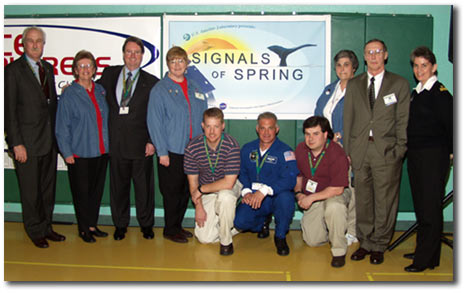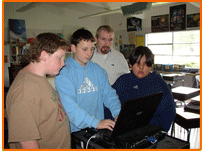 | In this Section: | |  | In the Spotlight |  | News |  |
List of "In the Spotlight" Features
NASA Explorer School, Learning with Signals of Spring, Receives Special Visit!
Sixth, seventh and eighth graders at the Chapman School in Sheridan, Oregon, are taking an unusual approach to their Signals of Spring studies—instead of focusing on one animal, they are studying all of them. From monk seals to red-tailed hawks, Chapman students are tracking animals on the move with the guidance of their teachers Tim Hart, Ray Horton and Roxanne Henley. By taking this unique approach, students have the opportunity to compare the different species, for example discussing why one bird species began migrating for the spring, but another is still in its wintering grounds. By studying the gray whale, students have learned the difference between satellite and observational data.
NASA Administrator Sean O'Keefe, LEFT, visits NASA Explorer School
 |
According to Mr. Hart, the students have been, “amazingly successful.” Mr. Hart explains that, to the students, “This [program] is real to them; you’ve got them hooked! They are excited.” In just a few months, Chapman students have taken off with the project; they have really seen how environmental processes affect living things, and how humans are interconnected with nature. These students have explored local connections to the animals they are studying, from tracking native species to relating birds to hunting, poaching, wildlife, and agricultural problems. They have made beautiful wall displays and even presented their findings to visitors from NASA including Chief Administrator Sean O'Keefe!
 The teachers have interwoven Signals of Spring into the school’s technology and science curricula. Students have become experts at making good observations and understanding the connections between the physical and life sciences, when weather affects bird movements for example. Mr. Hart pointed out that Signals of Spring pushes “kids to go more in depth” with science concepts. Mr. Hart hopes to extend Signals of Spring in the future by making it a full-year program, and connecting with local scientists and allow students to see possibilities for future careers. He explains, “There are so many extensions you can do to go beyond,” and emphasizes the importance of exposing students to a wide variety of career opportunities, “They are our next generation.”
The teachers have interwoven Signals of Spring into the school’s technology and science curricula. Students have become experts at making good observations and understanding the connections between the physical and life sciences, when weather affects bird movements for example. Mr. Hart pointed out that Signals of Spring pushes “kids to go more in depth” with science concepts. Mr. Hart hopes to extend Signals of Spring in the future by making it a full-year program, and connecting with local scientists and allow students to see possibilities for future careers. He explains, “There are so many extensions you can do to go beyond,” and emphasizes the importance of exposing students to a wide variety of career opportunities, “They are our next generation.”
For more information about NASA Explorer Schools, go to explorerschools.nasa.gov.
|
 The teachers have interwoven Signals of Spring into the school’s technology and science curricula. Students have become experts at making good observations and understanding the connections between the physical and life sciences, when weather affects bird movements for example. Mr. Hart pointed out that Signals of Spring pushes “kids to go more in depth” with science concepts. Mr. Hart hopes to extend Signals of Spring in the future by making it a full-year program, and connecting with local scientists and allow students to see possibilities for future careers. He explains, “There are so many extensions you can do to go beyond,” and emphasizes the importance of exposing students to a wide variety of career opportunities, “They are our next generation.”
The teachers have interwoven Signals of Spring into the school’s technology and science curricula. Students have become experts at making good observations and understanding the connections between the physical and life sciences, when weather affects bird movements for example. Mr. Hart pointed out that Signals of Spring pushes “kids to go more in depth” with science concepts. Mr. Hart hopes to extend Signals of Spring in the future by making it a full-year program, and connecting with local scientists and allow students to see possibilities for future careers. He explains, “There are so many extensions you can do to go beyond,” and emphasizes the importance of exposing students to a wide variety of career opportunities, “They are our next generation.”
